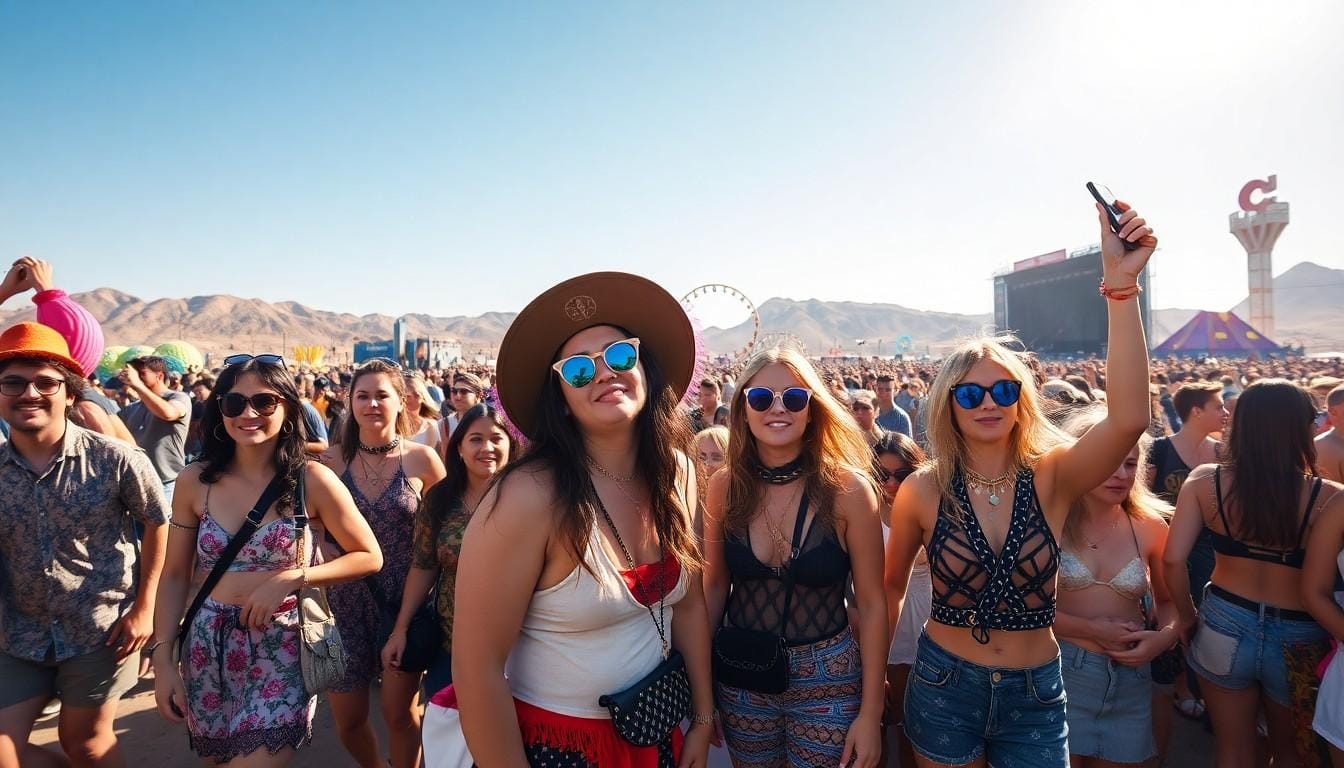For the past 20 years, the Coachella Valley Music and Arts Festival has established itself as one of the world’s most renowned music festivals. Held at the Empire Polo Club in Indio, California, this iconic event unfolds over two consecutive weekends each spring, attracting thousands of music lovers and trendsetters from around the globe.
What makes Coachella truly special is its diverse lineup featuring artists across multiple genres – from rock standouts and indie bands to mainstream pop performers like Lady Gaga, Beyoncé, and Green Day. Beyond music, the festival showcases impressive art installations and interactive experiences against a stunning desert backdrop. With eight outdoor stages hosting dozens of performers from 1 pm until midnight, Coachella has become a cultural phenomenon that combines exceptional musical performances with a vibrant art scene.
Table of Contents
The History of Coachella Valley Music and Arts Festival
The Coachella Valley Music and Arts Festival originated in 1999 as a counterculture music event in the California desert. From its humble beginnings to becoming one of the world’s most influential music gatherings, Coachella’s evolution reflects changing music trends, cultural shifts, and the growing intersection of art and entertainment in festival culture.
Origins and Evolution
Coachella began in October 1999 as a two-day festival at the Empire Polo Club in Indio, California. The inaugural event featured headliners Beck and Rage Against the Machine, attracting over 25,000 attendees despite failing to generate profit. This initial festival occurred just months after the disastrous Woodstock ’99, creating uncertainty about the financial viability of multi-stage weekend events.
After taking a strategic one-year hiatus, organizers relaunched Coachella in April 2001 as a single-day event. This scheduling change deliberately avoided the extreme desert temperatures experienced during the October debut. The festival returned to its two-day format the following April, establishing a spring timeframe that would become its signature season.
Coachella’s expansion continued steadily over the following decade, adding a third day in 2010 to accommodate growing artist lineups and audience demand. A transformational shift occurred in 2012 when the festival adopted its current six-day format spread across two consecutive weekends, effectively doubling its capacity and cultural impact.
The festival’s location at the Empire Polo Club in Indio has remained constant throughout its history, creating a sense of geographical identity that distinguishes Coachella from other nomadic festivals. This consistency allowed organizers to develop increasingly elaborate stage designs, infrastructure improvements, and iconic art installations that have become hallmarks of the Coachella experience.
Financially, Coachella evolved from its money-losing first year to become one of the most profitable music festivals globally. This economic success enabled organizers to secure higher-profile acts, invest in technological advancements, and expand the artistic components beyond music into large-scale installations, interactive experiences, and multimedia productions.
Iconic Performances Through the Years
Coachella’s performance history captures pivotal moments in contemporary music across multiple genres. The festival has earned a reputation for featuring groundbreaking artists alongside reuniting legendary acts, creating memorable cultural milestones.
Rage Against the Machine’s appearance at the inaugural 1999 festival set the tone for Coachella’s political edge and energetic performances. Their raw intensity established a standard for festival headliners that continues to influence booking decisions.
As Coachella evolved through the 2000s, it became known for showcasing indie rock and alternative acts before they achieved mainstream recognition. Performances by Arcade Fire, The Killers, and LCD Soundsystem during this era helped establish Coachella as a tastemaker festival with the power to launch artists into broader popularity.
The 2006 edition marked a turning point with Daft Punk’s revolutionary pyramid stage show, introducing electronic dance music as a central component of the festival experience. This performance transformed expectations for production values and visual elements in festival performances, influencing countless artists and events that followed.
Coachella’s capacity to create cultural moments expanded further with Beyoncé’s 2018 performance, nicknamed “Beychella” by fans and critics. Her elaborately choreographed set, featuring over 100 dancers and a full marching band, paid homage to historically Black colleges and universities while demonstrating how festival performances could become artistic statements that transcend the event itself.
Other standout performances include Prince’s last-minute addition to the 2008 lineup, featuring his iconic cover of Radiohead’s “Creep”; Dr. Dre and Snoop Dogg’s 2012 set that included the holographic resurrection of Tupac Shakur; and Lady Gaga’s 2017 headlining spot that brought mainstream pop spectacle to the desert.
The festival has also become known for hosting significant band reunions, including The Pixies (2004), Rage Against the Machine (2007), Outkast (2014), and Guns N’ Roses (2016). These nostalgic reunions attract multi-generational audiences while connecting contemporary attendees with music history.
Recent years have seen Coachella embracing global music trends, featuring K-pop sensations BLACKPINK, Latin artists Bad Bunny and J Balvin, and an increasing number of international performers. This evolution reflects the festival’s ongoing commitment to presenting diverse musical perspectives while anticipating emerging cultural movements.
Art installations have evolved alongside musical performances, becoming increasingly elaborate and interactive. These works transform the festival grounds and create distinct visual identities for each year’s event, serving as meeting points, photo opportunities, and artistic statements in their own right.
The 2023 festival featured nine international designers, artists, and collectives who created sculptural works that served as colorful architectural beacons throughout the grounds. Artists like Kumkum Fernando, Vincent Leroy, Guvenç Özel, and Maggie West contributed pieces that changed appearance throughout the day and night, adding dynamic visual elements to complement the musical experience.
Festival Experience
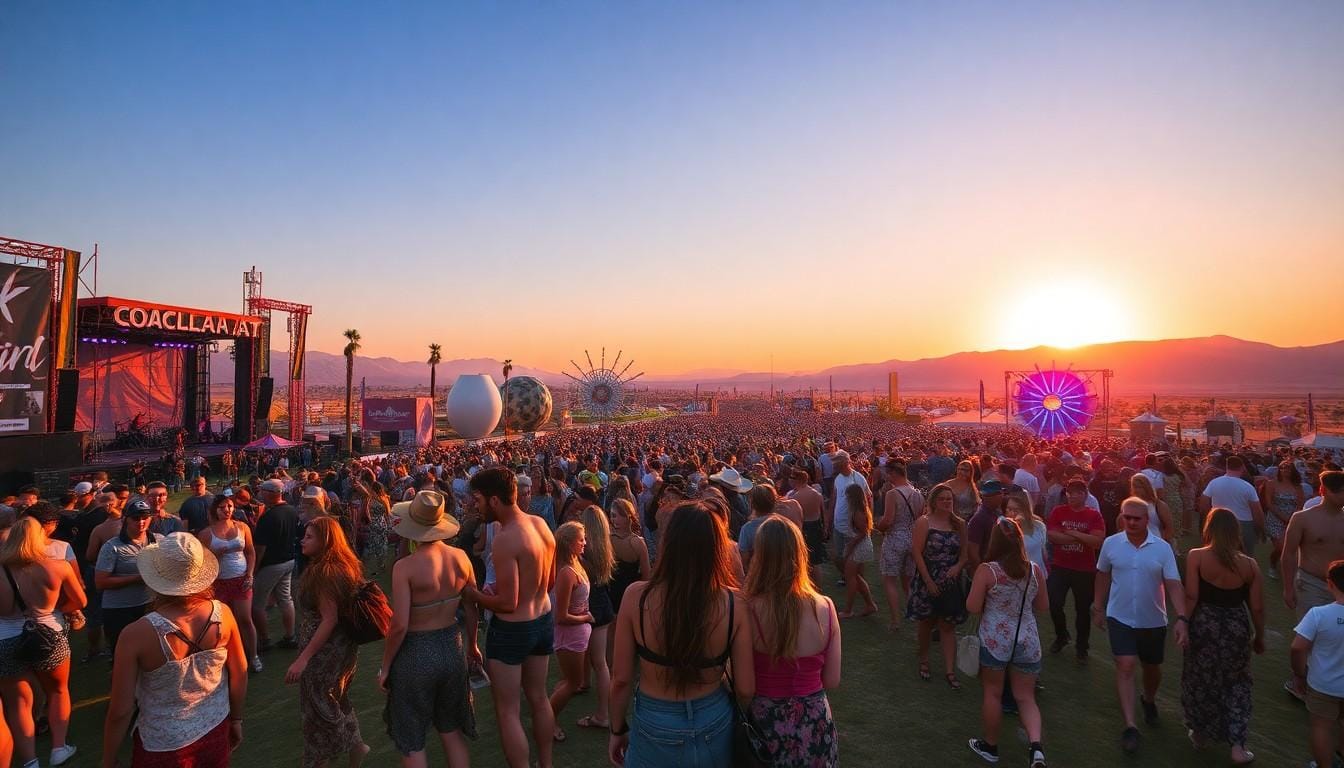
The Coachella Valley Music and Arts Festival transforms the Empire Polo Club in Indio, California into an immersive cultural celebration that attracts over 250,000 attendees across two consecutive three-day weekends. This desert oasis festival combines musical performances, artistic expression, and community engagement in the Colorado Desert’s Coachella Valley, creating a multisensory experience that extends far beyond typical concert settings.
Music Stages and Lineup Structure
Coachella’s musical offerings spread across multiple carefully designed stages, each with its own character and atmosphere. The main Coachella Stage hosts headlining acts and draws the largest crowds, while the Outdoor Theatre provides a slightly more intimate setting for major performers. Smaller venues like the Gobi, Mojave, Sahara, Yuma, and Sonora stages showcase emerging artists, electronic music, and alternative genres.
The festival’s lineup structure typically features headliners performing last each night, with performances running continuously across all stages from early afternoon until midnight. This strategic scheduling allows attendees to experience dozens of artists daily, with the same lineup repeating during both weekends. Notable past headliners include Lady Gaga, Green Day, Post Malone, and countless groundbreaking artists spanning indie, pop, R&B, and electronic genres.
Each stage offers distinct production elements—the Sahara Tent focuses on EDM performances with advanced light shows, while the Yuma Tent recreates an underground club atmosphere for house and techno fans. The festival’s scheduling often creates intentional overlaps that distribute crowds throughout the grounds while giving attendees meaningful choices between concurrent performances.
Art Installations and Visual Culture
Art installations form a crucial component of Coachella’s identity, transforming the festival grounds into an open-air gallery that enhances the sensory experience. Massive sculptures, interactive exhibits, and multimedia presentations dot the landscape, creating landmarks that serve both as meeting points and conversation starters among attendees.
The festival commissions original works from international artists that range from towering structures visible across the grounds to intimate, interactive pieces hidden in quiet corners. These installations often incorporate light, sound, and movement elements that evolve as day transitions to night, creating entirely different visual experiences depending on when attendees encounter them.
Beyond the official installations, Coachella’s visual culture extends to fashion, with attendees embracing desert boho aesthetics that have influenced broader fashion trends. The festival grounds transform into a photographer’s paradise, with countless Instagram-worthy moments that connect the in-person experience to digital documentation and sharing.
The art program has grown significantly over the years, with increasing budgets and prominence within the festival experience. Many installations address environmental themes, social issues, or technological innovation, adding intellectual depth to their visual impact and creating meaningful cultural touchpoints throughout the festival grounds.
Planning Your Coachella Trip
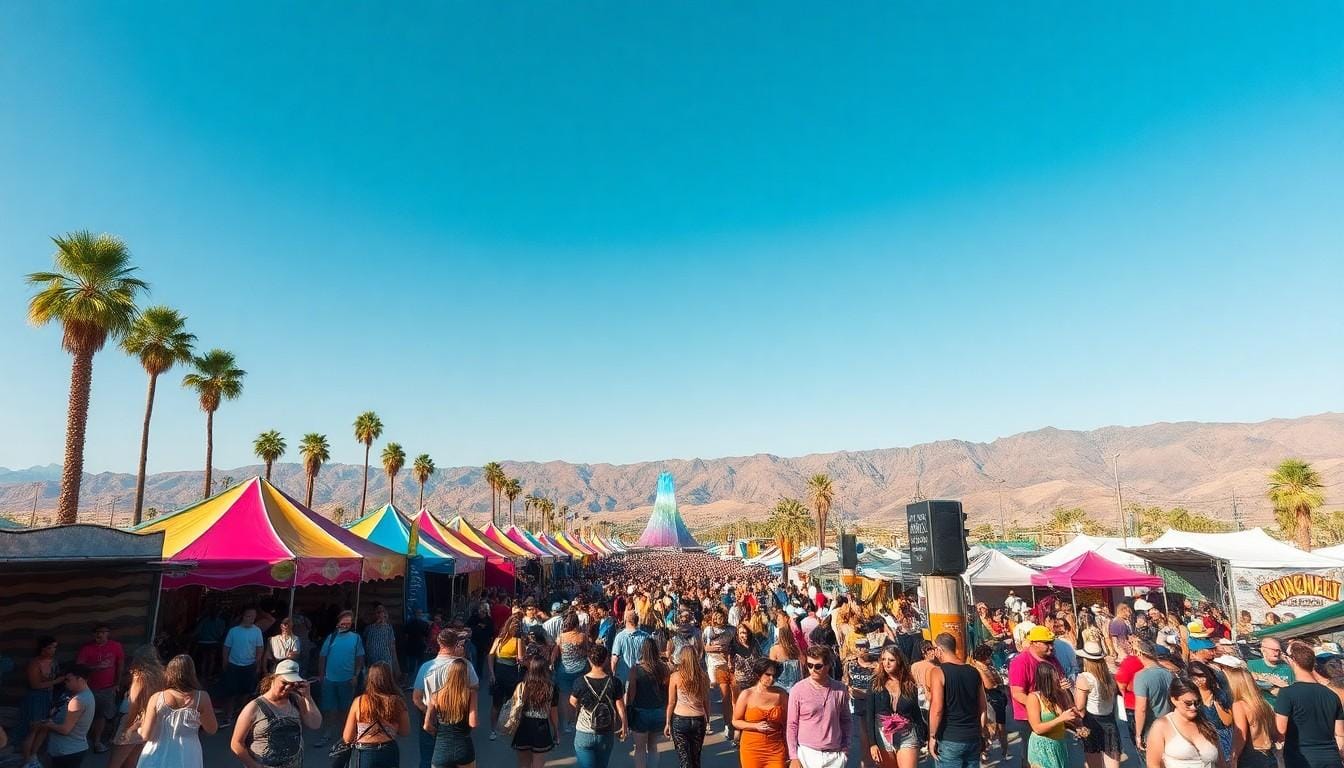
Planning a trip to Coachella requires attention to several key details, from securing tickets to finding suitable accommodation options. The festival’s popularity means early preparation is essential for the best experience.
Dates and Location
The Coachella Valley Music and Arts Festival for 2025 takes place at the Empire Polo Club in Indio, California, spanning two consecutive weekends:
- Weekend 1: April 11-13, 2025
- Weekend 2: April 18-20, 2025
Each weekend offers identical lineups but distinct atmospheres, with the first weekend typically attracting more first-time attendees and media coverage, while the second weekend often features more relaxed crowds and improved artist performances based on first-weekend experiences.
Ticket Options and Pricing
Coachella offers various ticket tiers designed to accommodate different budgets and experience preferences. Understanding these options helps festival-goers make informed decisions about their attendance.
Ticket Types
- General Admission (GA): Starts at $499 for one weekend. GA passes provide access to the festival grounds, parking lots, and all general areas, including GA camping zones. These passes serve as the entry-level option for most attendees.
- General Admission + Shuttle Pass: Combines standard GA access with convenient shuttle service between the festival and designated locations throughout the Coachella Valley. This option eliminates parking hassles and transportation concerns.
- VIP Passes: Premium festival experience starting at $1,119 per weekend. VIP pass holders enjoy exclusive benefits such as:
- Private lounges with premium food and beverage options
- Enhanced viewing areas for better stage visibility
- Dedicated restroom facilities with shorter lines
- Expedited entry through designated VIP entrance lanes
Ticket Purchase
Tickets become available through the official Coachella website several months before the festival. The purchase process typically follows a structured timeline:
- Advance Sale: Occurs shortly after the previous year’s festival
- General Sale: Launches after the lineup announcement
- Payment Plan Options: Available during both sales periods, allowing purchases with installment payments
Due to high demand, tickets often sell out within hours of release. Creating an account on the Coachella website before sales begin streamlines the purchase process.
Accommodation Choices
Finding suitable lodging ranks among the most critical aspects of festival planning. Coachella offers multiple accommodation options catering to different preferences and budgets.
On-Site Camping
Camping directly on the festival grounds provides the most immersive Coachella experience with these options:
- Car Camping: Priced at approximately $149 per spot (not per person). Each space accommodates one vehicle and adjacent camping equipment. Spots measure 10’×30′, allowing enough room for a standard car and modest camping setup.
- Tent Camping: Similar to car camping but without vehicle access. Ideal for those arriving via shuttle or rideshare services. Campers must carry their equipment from designated drop-off points.
- Lake Eldorado: Premium camping experience featuring pre-set tents and teepees near a man-made lake. Options include:
- 2-person tents starting around $2,750
- 4-person tents starting around $3,800
- All packages include festival passes
On-site camping amenities include:
- Shower facilities
- Restrooms
- Food vendors
- General stores
- Charging stations
- The Camping Hub social area with activities and entertainment
Safari Camping
Safari Camping represents the luxury camping tier, offering:
- Fully furnished, air-conditioned Safari tents
- Private restrooms and shower facilities
- Dedicated concierge service
- Exclusive lounge areas
- Golf cart transportation around the festival grounds
- Prices starting at approximately $9,500 for two people (including festival passes)
Hotel Packages
Official Coachella hotel packages combine festival passes with accommodations at partner hotels throughout the Coachella Valley. Benefits include:
- Guaranteed festival passes
- Shuttle transportation between hotels and festival grounds
- Exclusive hotel pool parties and events
- Prices varying based on hotel category (standard, premium, or luxury)
Popular hotel package locations include Palm Springs, Rancho Mirage, Indian Wells, and La Quinta, with distance from the venue reflected in pricing.
Vacation Rentals
The areas surrounding Indio offer numerous private home and condo rentals through platforms like Airbnb and VRBO. These options provide:
- More space and privacy than hotels
- Kitchen facilities for meal preparation
- Cost-effective accommodations for larger groups
- Potential pool access and other amenities
Booking vacation rentals requires early action, as properties within reasonable distance to the festival grounds are reserved months in advance, with prices typically increasing 2-3 times normal rates during festival weekends.
By carefully considering these planning elements, Coachella attendees can create a festival experience that aligns with their preferences and budget constraints while ensuring they don’t miss out on this renowned music and arts celebration.
Survival Guide
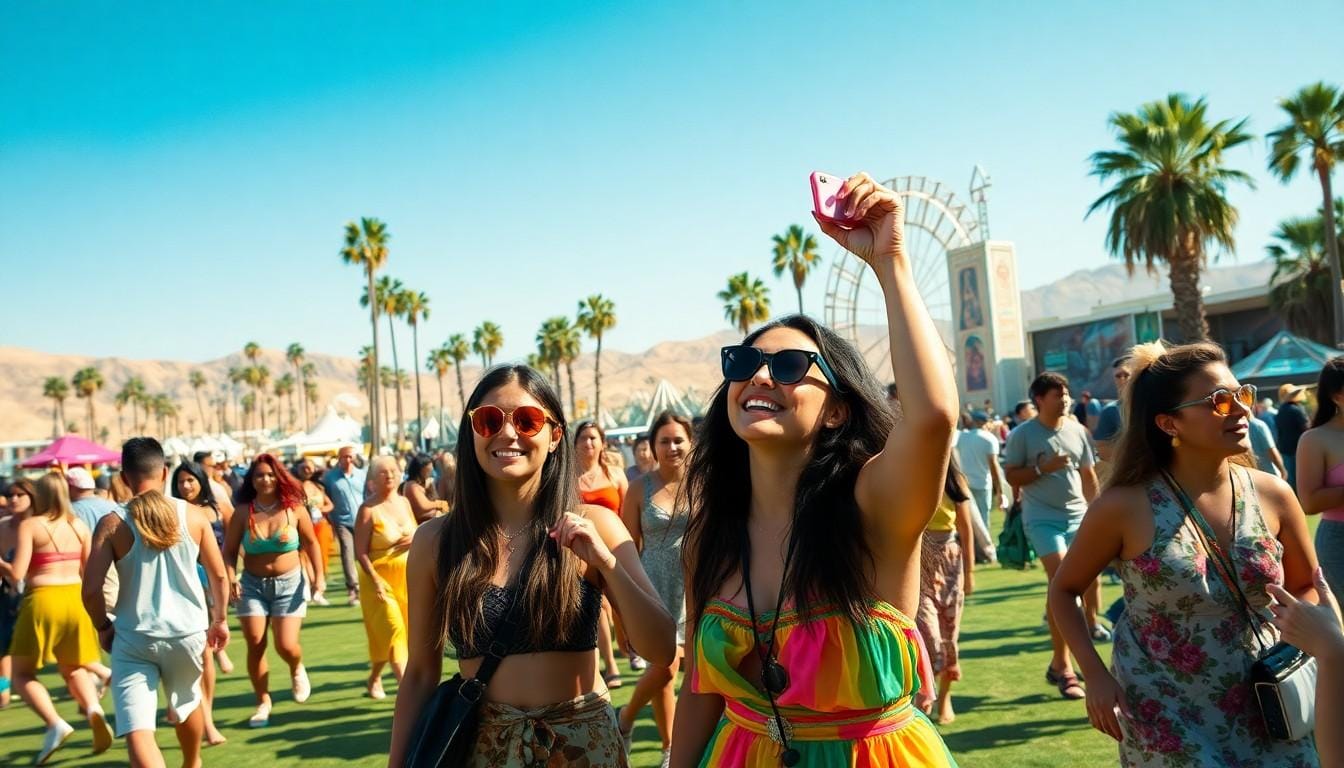
Navigating the Coachella Valley Music and Arts Festival requires strategic planning and preparation. This survival guide offers essential tips to maximize your festival experience while avoiding common pitfalls that can diminish your enjoyment at this iconic desert event.
What to Pack
Packing appropriately for Coachella ensures comfort throughout long festival days in the desert climate. The right gear makes a significant difference when spending 10+ hours outdoors in varying temperatures.
Essential Items:
- Reusable water bottle – Access water refill stations throughout the festival grounds to stay hydrated without spending on bottled water. Dehydration poses serious risks in the desert heat, so keeping water accessible at all times is crucial.
- Portable charger/backup battery – Festival-goers typically drain phone batteries quickly when taking photos, using maps, and coordinating with friends. Multiple chargers provide security for full-day use.
- Sunscreen and SPF lip balm – The Indio sun remains intense throughout the day. Apply sunscreen regularly, even on cloudy days. Free sunscreen stations exist as backup, but bringing your own ensures protection.
- Comfortable shoes – Festival attendees walk approximately 20,000 steps daily across the grounds. Choose broken-in, closed-toe shoes to protect feet in crowded areas and provide support for extended standing.
- Bandana or mask – Desert dust storms occur frequently, making protective face coverings essential. Bandanas serve multiple purposes: neck protection from sun, face covering during dust, and cooling when dampened.
- Hat and sunglasses – Direct sun exposure lasts all day, particularly when viewing performances at the Coachella and Outdoor stages where shade remains minimal. Wide-brimmed hats provide face and neck protection.
- Light jacket or sweater – Desert temperatures drop significantly after sunset, often by 20-30 degrees. Layers accommodate temperature fluctuations between hot days and cool evenings.
- Portable fan – Small battery-operated fans provide relief during peak afternoon heat when temperatures regularly exceed 90°F.
- Earplugs – Protect hearing during loud performances, especially when positioning close to speakers or attending multiple shows consecutively.
- Hand sanitizer and wet wipes – Limited handwashing facilities make sanitizer essential. Wet wipes clean hands, face, and body throughout dusty days.
- Small backpack or fanny pack – Carry essentials while keeping hands free for dancing and activities. Check size restrictions on Coachella’s official website as oversized bags aren’t permitted.
- Cash and cards – While many vendors accept cards, cash provides backup for small purchases and situations where card readers malfunction due to connectivity issues.
- Festival map – Download the Coachella app for digital maps, but bring a paper backup for when battery drains or connectivity fails.
- Light snacks – Energy bars and sealed snacks maintain energy between meals without breaking festival outside food policies.
Items to Leave Behind:
Coachella maintains strict prohibited items policies. Avoid bringing:
- Glass containers of any kind
- Large umbrellas or shade structures
- Professional cameras with detachable lenses
- Drones or recording equipment
- Outside alcohol
- Illegal substances
- Selfie sticks
- Weapons of any kind
Check the complete prohibited items list on the official Coachella website before packing to avoid confiscation at entry points.
Transportation Tips
Transportation planning dramatically impacts the Coachella experience, affecting arrival times, energy levels, and overall convenience. Multiple options accommodate different budgets and preferences.
Festival Shuttle Passes:
The official Coachella shuttle system provides reliable transportation between designated stops and the festival grounds. Benefits include:
- Dedicated lanes that bypass regular traffic
- Air-conditioned vehicles with comfortable seating
- Regular departures throughout festival hours
- Multiple pickup locations throughout Greater Palm Springs
- Environmentally friendlier than individual vehicles
- No parking hassles or designated driver concerns
Shuttle passes cost approximately $84 for the weekend and require advance purchase as they frequently sell out.
Rideshare Services:
Uber and Lyft operate during Coachella with designated pickup and dropoff zones. Consider these factors:
- Peak times (particularly after headliners finish) create extreme demand
- Surge pricing increases costs significantly, sometimes 3-5x normal rates
- Dedicated rideshare lots require walking from festival exits
- Cell service becomes unreliable when thousands attempt to request rides simultaneously
- Pre-scheduling return rides helps avoid lengthy waits
Scheduling rideshare pickups 30-45 minutes before desired departure time accounts for delays and connection issues.
Driving and Parking:
Self-driving provides flexibility but presents challenges:
- General parking requires advance purchase ($140-$180 for weekend passes)
- Preferred parking ($160-$225) positions vehicles closer to entrances
- Traffic congestion adds 1-2 hours to journey times during peak entry/exit periods
- Navigation apps often suggest alternate routes that become equally congested
- Designate a sober driver if consuming alcohol
- Take photos of parking location markers to find your vehicle later
Arrive before noon to minimize traffic delays and secure better parking positions.
Car Camping:
Car camping eliminates daily transportation concerns while creating a community experience:
- Each car camping spot accommodates one vehicle and up to four people
- Spaces measure 10×30 feet, providing room for a vehicle and modest camping setup
- Communal shower facilities have limited capacity with potential waiting times
- Camp activities begin Thursday before the festival
- Early arrival secures preferred camping locations closer to festival entrances
- Camping passes ($149-$189) sell out quickly after ticket releases
Review camping regulations carefully, as prohibited items differ from general festival rules.
Local Transportation Tips:
- Coachella traffic impacts all Indio roadways during festival weekends
- Allow double normal travel times for any local movements
- Alternative routes through residential areas become equally congested
- Police checkpoints appear frequently around festival perimeters
- Morning departures (before 10am) and late-night returns encounter less traffic
- Consider biking for nearby accommodations within 3-5 miles of venue
Airport Transportation:
For those flying into the region:
- Palm Springs International Airport (PSP) offers closest access (30-40 minutes from venue)
- Los Angeles (LAX) and San Diego airports require 2.5-3 hour drives without traffic
- Airport shuttles provide direct service to hotels and festival grounds
- Rental cars require advance booking during festival weeks
- Rideshare services from airports face high demand with potential long waits
Book ground transportation from airports weeks in advance to secure availability.
Navigation Strategies:
- Download offline maps before arriving as cell service becomes unreliable
- Use the official Coachella app for real-time traffic updates and parking guidance
- Check social media for attendee reports on traffic conditions
- Plan multiple route options in advance
- Identify landmarks to orient yourself when returning to parking areas
- Screenshot directions and meeting points rather than relying on continuous data access
Understanding transportation logistics transforms a potentially stressful commute into a manageable part of the festival experience. Planning multiple options provides flexibility when primary transportation methods face delays or disruptions.
Coachella’s Cultural Impact
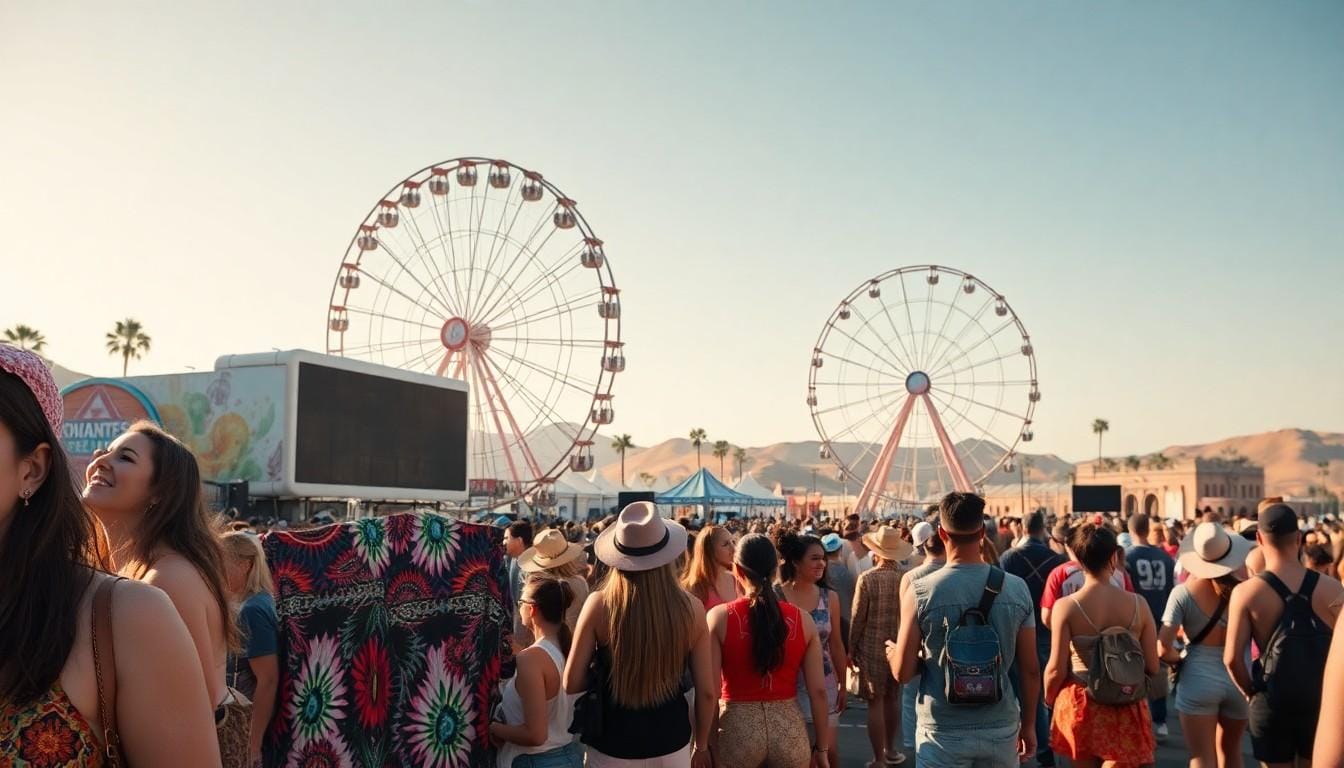
Coachella Valley Music and Arts Festival has transformed from a modest music event into a global cultural phenomenon that shapes trends across multiple industries. Since its inception in 1999, the festival has evolved into a barometer for what’s considered cutting-edge in entertainment, fashion, and digital culture.
Influence on Music Festival Industry
Coachella redefined the modern music festival format through its innovative approach to programming and experience design. The festival pioneered the multi-weekend model, expanding from a single weekend to two identical weekends in 2012, a strategy now adopted by numerous festivals worldwide. This approach doubled attendance capacity while maintaining the exclusive atmosphere that draws both artists and attendees.
The festival’s genre evolution mirrors shifting audience preferences, having expanded from its alternative rock roots to embrace EDM, hip-hop, R&B, and pop acts. Early lineups featured Pearl Jam, Morrissey, and Rage Against the Machine, establishing Coachella’s independent credibility before gradually incorporating mainstream performers.
Coachella’s economic impact extends beyond ticket sales, generating over $700 million annually for the local economy. This financial success has prompted cities and venues across the country to develop their own festival concepts, attempting to replicate Coachella’s combination of musical diversity, artistic expression, and destination appeal.
The festival’s artist reunion strategy has become particularly influential, with Coachella offering substantial compensation to reunite beloved bands. These reunion performances often become the catalyst for full-scale comeback tours, positioning Coachella as a kingmaker in the industry with the power to resurrect careers and reintroduce artists to new generations.
Production values at Coachella have raised standards across the festival landscape. The event’s investment in sound quality, stage design, and technical capabilities forces competing festivals to enhance their own offerings, resulting in increasingly sophisticated concert experiences industry-wide.
Social Media and Fashion Trends
Coachella’s influence extends dramatically into fashion and digital culture, functioning as both runway and content factory for contemporary style trends. The festival grounds have become a real-time fashion showcase where bohemian-chic aesthetics blend with contemporary streetwear, creating instantly recognizable “festival fashion” that retailers replicate seasonally.
Fashion brands recognize Coachella’s marketing potential, with major labels hosting activation areas, pop-up shops, and exclusive parties that generate content across social platforms. These branded experiences transform festival attendance into commercial opportunities, with influencer partnerships amplifying reach beyond physical attendees.
The festival generates approximately 43 million social media impressions during each weekend, with attendees posting outfits, performances, and art installations across platforms. This content creation aspect has become so central to the experience that designated photo opportunities and Instagram-worthy backdrops are strategically placed throughout the grounds.
Celebrity attendance significantly amplifies Coachella’s fashion influence, with paparazzi documenting styles that quickly transition from festival grounds to retail floors. Major retailers analyze Coachella street style to inform their summer collections, with “festival collections” becoming standard seasonal offerings at brands ranging from fast fashion to luxury labels.
Digital content created at Coachella drives engagement far beyond the event itself, with hashtags like #Coachella and #CoachellaFashion generating millions of posts annually. This content ecosystem creates year-round relevance for the festival, maintaining cultural conversation even during off-season months.
The festival’s fashion influence has democratized participation, allowing those who cannot attend physically to engage with the aesthetic through social media and retail offerings. This accessibility transforms Coachella from a ticketed event into a cultural moment with global participation, cementing its position as more than just a music festival but a defining cultural touchstone that shapes trends across industries.
Conclusion
Coachella stands as more than just a music festival—it’s a cultural force that has redefined entertainment across two decades. From its humble beginnings to becoming a global phenomenon attracting 250,000+ attendees the event has evolved into an immersive experience where music art and fashion converge.
The festival continues to push boundaries with innovative performances legendary headliners and breathtaking art installations while generating massive economic impact for the region. Its influence extends far beyond Indio’s desert landscape shaping worldwide trends in music production fashion and digital content.
Whether you’re planning your first visit or returning for another unforgettable weekend proper preparation will enhance your experience at this transformative celebration that has rightfully earned its place as one of the world’s premier cultural gatherings.
Frequently Asked Questions
When and where does Coachella take place?
Coachella Valley Music and Arts Festival takes place at the Empire Polo Club in Indio, California. The festival occurs over two weekends each spring. For 2025, the dates are April 11-13 and April 18-20. Each weekend features essentially the same lineup, though the atmosphere may differ slightly between the first and second weekends.
How much do Coachella tickets cost?
Coachella tickets vary in price depending on the type. General Admission passes typically start around $499, while VIP passes cost approximately $1,000. Additional options include shuttle passes, camping passes, and luxury packages that can range from $2,500 to $9,500 for premium experiences. Prices may increase as the event approaches, so early purchase is recommended.
What accommodation options are available for Coachella?
Accommodation options include on-site camping (car camping or tent camping), luxury Safari Tents, local hotels, vacation rentals, and hotel packages through Valley Music Travel. On-site camping starts at about $125 for car camping, while luxury Safari Camping can cost $10,000+. Hotel packages typically include festival passes and shuttle transportation to and from the venue.
What should I pack for Coachella?
Essential items include a reusable water bottle, portable charger, sunscreen, hat, sunglasses, comfortable shoes, light layers for evening temperature drops, dust mask or bandana, and ear protection. Desert temperatures fluctuate dramatically, so prepare for hot days (90°F+) and cool nights (50°F). Don’t forget toiletries, hand sanitizer, and any necessary medications.
Do celebrities attend Coachella?
Yes, celebrities regularly attend Coachella. The festival has become a cultural hotspot that attracts numerous high-profile attendees from the entertainment industry. Many celebrities attend as regular festivalgoers, while others perform on stage. The celebrity presence has contributed to Coachella’s reputation as a see-and-be-seen event beyond just a music festival.
Who is headlining Coachella 2025?
The rumored headliners for Coachella 2025 include Lady Gaga, Green Day, Post Malone, and Travis Scott. The festival typically features a diverse lineup spanning multiple genres, from rock and indie to hip-hop, EDM, and mainstream pop. Official lineup announcements usually occur a few months before the festival.
Is there an age restriction for Coachella?
Coachella is an all-ages event. Children 5 and under can attend for free. However, anyone under 18 must be accompanied by an adult when entering or exiting the festival grounds and campgrounds. All attendees, regardless of age, require a festival pass for entry.
What transportation options are available to and from Coachella?
Transportation options include the official Coachella shuttle service (passes available for purchase), rideshare services like Uber and Lyft (with designated pickup/dropoff areas), driving and parking at the venue (parking passes required), or hotel shuttles if staying at partner hotels. Many attendees find the shuttle service most convenient to avoid traffic and parking challenges.
What art installations can I expect at Coachella?
Coachella features large-scale, immersive art installations from international artists that transform the festival grounds into an open-air gallery. These installations often address environmental and social themes, creating photo-worthy moments throughout the venue. The art program changes annually, with new commissioned works appearing alongside returning favorites, making each year’s visual landscape unique.
Are there shower facilities at Coachella camping?
Yes, shower facilities are available at all camping areas. General camping has communal shower trailers with varying wait times, especially during peak morning hours. VIP and premium camping areas offer enhanced shower facilities with shorter lines. Many experienced campers recommend showering during off-peak hours (late afternoon) or bringing portable shower options for convenience.
AMW® is a marketing and entertainment group that provides a wide range of marketing and event platforms throughout the World. AMW® partner with leading brands, companies, and media to help bring growth to their businesses through marketing, communications, and special events. Learn more

